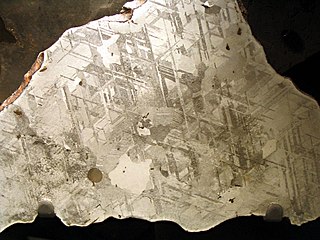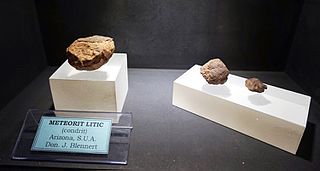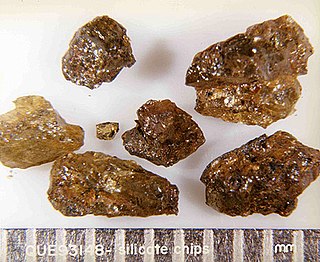
Kamacite is an alloy of iron and nickel, which is found on Earth only in meteorites. According to the International Mineralogical Association (IMA) it is considered a proper nickel-rich variety of the mineral native iron. The proportion iron:nickel is between 90%:10% and 95%:5%; small quantities of other elements, such as cobalt or carbon may also be present. The mineral has a metallic luster, is gray and has no clear cleavage although its crystal structure is isometric-hexoctahedral. Its density is about 8 g/cm3 and its hardness is 4 on the Mohs scale. It is also sometimes called balkeneisen.

Peridot, sometimes called chrysolite, is a deep yellowish-green transparent variety of olivine. Peridot is one of the few gemstones that occurs in only one color.

In meteoritics, a meteorite classification system attempts to group similar meteorites and allows scientists to communicate with a standardized terminology when discussing them. Meteorites are classified according to a variety of characteristics, especially mineralogical, petrological, chemical, and isotopic properties.

A chondrite is a stony (non-metallic) meteorite that has not been modified, by either melting or differentiation of the parent body. They are formed when various types of dust and small grains in the early Solar System accreted to form primitive asteroids. Some such bodies that are captured in the planet's gravity well become the most common type of meteorite by arriving on a trajectory toward the planet's surface. Estimates for their contribution to the total meteorite population vary between 85.7% and 86.2%.

Carbonaceous chondrites or C chondrites are a class of chondritic meteorites comprising at least 8 known groups and many ungrouped meteorites. They include some of the most primitive known meteorites. The C chondrites represent only a small proportion (4.6%) of meteorite falls.

The pallasites are a class of stony–iron meteorite.

Iron meteorites, also known as siderites, or ferrous meteorites, are a type of meteorite that consist overwhelmingly of an iron–nickel alloy known as meteoric iron that usually consists of two mineral phases: kamacite and taenite. Most iron meteorites originate from cores of planetesimals, with the exception of the IIE iron meteorite group

The Allende meteorite is the largest carbonaceous chondrite ever found on Earth. The fireball was witnessed at 01:05 on February 8, 1969, falling over the Mexican state of Chihuahua. After it broke up in the atmosphere, an extensive search for pieces was conducted and over 2 tonnes were recovered. The availability of large quantities of samples of the scientifically-important chondrite class has enabled numerous investigations by many scientists; it is often described as "the best-studied meteorite in history." The Allende meteorite has abundant, large calcium–aluminium-rich inclusions (CAI), which are among the oldest objects formed in the Solar System.

Pallasovka is a pallasite meteorite found in 1990 near the town of Pallasovka, Russia.

Mbozi is an ungrouped iron meteorite found in Tanzania. It is one of the world's largest meteorites, variously estimated as the fourth-largest to the eighth-largest, it is located near the city of Mbeya in Tanzania's southern highlands. The meteorite is 3 metres (9.8 ft) long, 1 metre high, and weighs an estimated 16 metric tons.

Lodranites are a small group of primitive achondrite meteorites that consists of meteoric iron and silicate minerals. Olivine and pyroxene make up most of the silicate minerals. Like all primitive achondrites lodranites share similarities with chondrites and achondrites.
Winonaites are a group of primitive achondrite meteorites. Like all primitive achondrites, winonaites share similarities with chondrites and achondrites. They show signs of metamorphism, partial melting, brecciation and relic chondrules. Their chemical and mineralogical composition lies between H and E chondrites.
The Brachina meteorite is the type specimen of the brachinites class of the asteroidal achondrites.

IAB meteorites are a group of iron meteorites according to their overall composition and a group of primitive achondrites because of silicate inclusions that show a strong affinity to winonaites and chondrites.

IIICD meteorites are a group of primitive achondrites. They are classified in a clan together with the IAB meteorites and the winonaites.

IVB meteorites are a group of ataxite iron meteorites classified as achondrites. The IVB group has the most extreme chemical compositions of all iron meteorites, meaning that examples of the group are depleted in volatile elements and enriched in refractory elements compared to other iron meteorites.

The Eagle Station meteorite is a pallasite and type specimen of the Eagle Station group.
IIG meteorites are a group of iron meteorites. The group currently has six members. They are hexahedrites with large amounts of schreibersite. The meteoric iron is composed of kamacite.
The Vermillion meteorite is a pallasite (stony-iron) meteorite and one of two members of the pyroxene pallasite grouplet.
This is a glossary of terms used in meteoritics, the science of meteorites.















